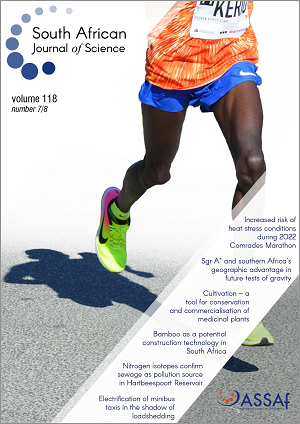CO2 storage potential of basaltic rocks, Mpumalanga: Implications for the Just Transition
DOI:
https://doi.org/10.17159/sajs.2022/12396Keywords:
carbon capture, utilisation and storage, CO2 sequestration, Ventersdorp Supergroup, Just TransitionAbstract
South Africa is the largest CO2 emitter on the African continent. These emissions stem from a heavy reliance on coal as the primary energy fuel and contributor toward socio-economic development. The South African government has targeted reducing CO2 emissions by more than half in the next 10 years. To meet climate change mitigation scenarios, while alleviating continued emissions, South Africa will look to technologies such as carbon capture, utilisation and storage. Initial assessments of South Africa’s potential for CO2 storage have focused on deep saline aquifers within volcano-sedimentary sequences along the near and offshore regions. Sustaining the Just Transition will, however, require additional storage capacity. In this study, we make an initial assessment of possible CO2 storage in basaltic sequences of the Ventersdorp Supergroup. Geological and mineralogical information was ascertained from borehole data. The geological information suggests that the subsurface extent of the Ventersdorp Supergroup is at least 80 000 km2 larger than previously mapped, extending beneath major point-source CO2 emitters and active coalfields. Furthermore, petrographic analyses suggest pore space of up to ca 15% with minimal alteration, and preservation of mafic silicate minerals that would enable reactive carbonation of injected CO2. Notable metasomatic and hydrothermal alteration is confined to significant contact horizons, such as the lowermost Ventersdorp Contact Reef. These results suggest that basaltic sequences may exponentially increase South Africa’s CO2 sequestration storage capacity and may have a significant impact on the country’s Just Transition.
Significance:
This study shows that basaltic sequences may support the permanent storage of anthropogenic CO2 in South Africa, in particular, proximal to significant point-source CO2 emitters. South Africa has voluminous and widespread basaltic sequences, which, in combination, increase South Africa’s geological CO2 storage potential by several orders of magnitude. These storage reservoirs can have a direct impact in South Africa by enabling a sustainable Just Transition toward a low-carbon economy while meeting intended climate change mitigation scenarios.
Published
Issue
Section
License

All articles are published under a Creative Commons Attribution 4.0 International Licence
Copyright is retained by the authors. Readers are welcome to reproduce, share and adapt the content without permission provided the source is attributed.
Disclaimer: The publisher and editors accept no responsibility for statements made by the authors
How to Cite
- Abstract 1192
- PDF 1042
- EPUB 389
- XML 326
Funding data
-
World Bank Group
Grant numbers TF0A3137












.png)